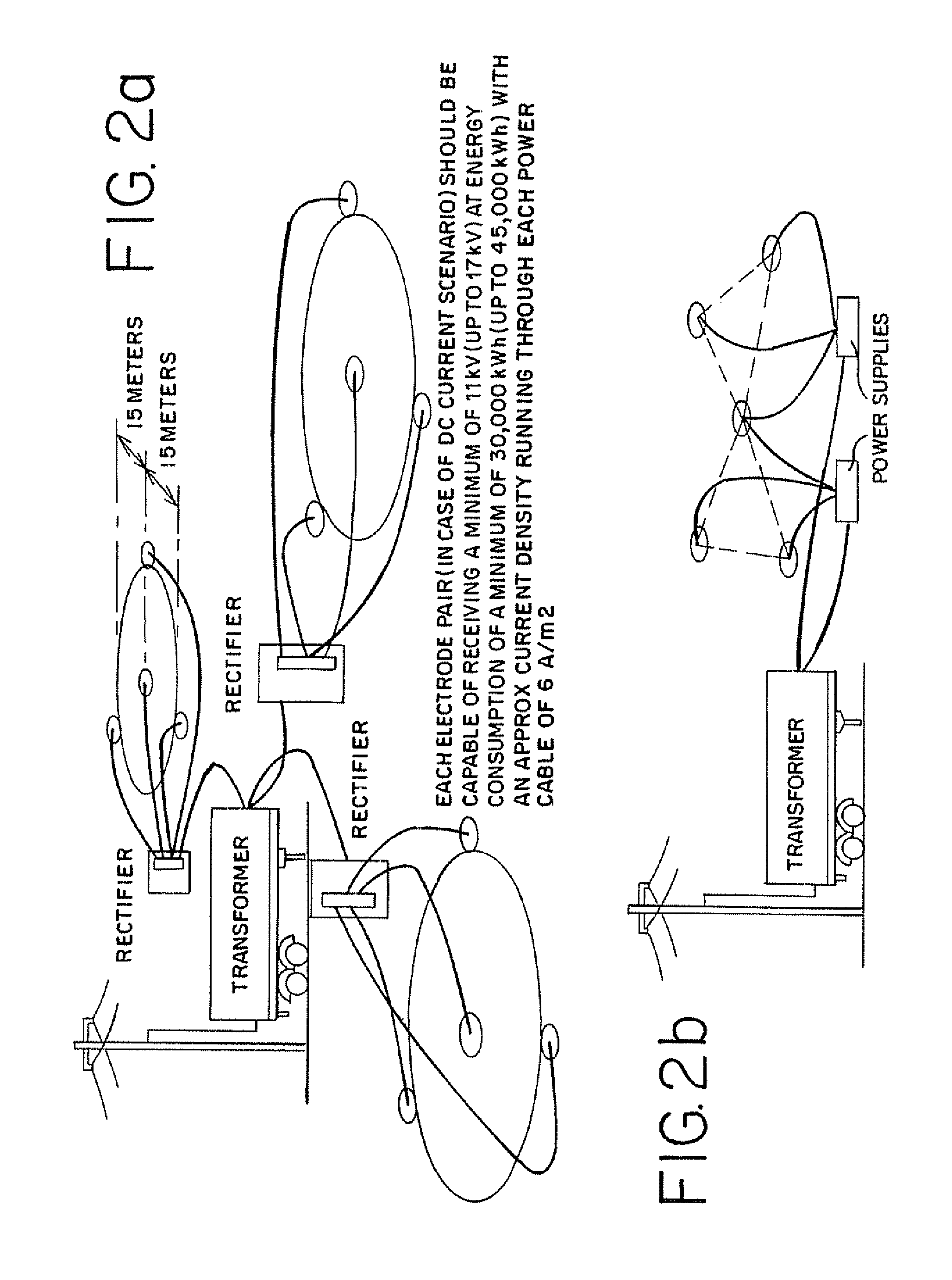Methods for extracting oil from tar sand
a technology of oil extraction and tar sand, which is applied in the direction of fluid removal, borehole/well accessories, insulation, etc., can solve the problems of significant wastewater disposal problems, large water supply and abundant energy,
- Summary
- Abstract
- Description
- Claims
- Application Information
AI Technical Summary
Benefits of technology
Problems solved by technology
Method used
Image
Examples
example 1
[0086]Hydrocarbons are extracted from 1 m3 of formation with electrodes 10 meters apart while varying heat treatment time.
[0087]Solving equation (7) with l=10 m, shall lead to the following formula (8).
U=583.1399.3+3166.5t;(8)
Table 4 presents results of calculations of U as a function of t, as well as derivative energy and costs calculations.
TABLE 4Calculated processing parameters vs estimated energy costs for the heat treatmentprocess.Current density,Sample heatSample heatRequired EnergyA / m2 (calculatedtreatment timetreatment time ofRequired voltageSupply need, E,using equation (4)of 1 m3 of1 m3 of formation,to performkWh (calculatedand area of 0.1 m2formation, hrsdaysoperation, Vper equation (3))used above)10.04234,81860.617.524113,439.4216.86.72401011,840.41,6835.92641111,823.21,845.95.97203011,715.84,941.45.86
example 2
[0088]Hydrocarbons are extracted using two 12″ (0.305 m) electrodes, 70 meters deep 10 meters apart while varying heat treatment time. The volume between the two electrodes is 213.5 m3.
[0089]Solving equations (5) and (7) will result in the following formula:
E=Q+E1=763.52t+11,492.7;
TABLE 5Calculated processing parameters vs. estimated energy requirement forthe heat treatment process.Current density,Heat treatmentRequired EnergyA / m2 (calculatedEnergytime of 213.5 m3Required voltageSupply need, E,using equation (4)requirement perofHeat treatmentto performkWh (calculatedand electrode areabarrel of oil,formation, hrstime, daysoperation, Vper equation (3))used above)kWh / bbl10.04233,88412,25616.936.624110,788.129,817.25.488.9240108,718.4194,737.54.4580.5264118,694.9213,061.34.3635.2
example 3
[0090]Hydrocarbons are extracted using two 12″ (0.305 m) electrodes, 70 meters deep, 15 meters apart while varying heat treatment time and assuming 100% yield of oil. The volume between the two electrodes is 320.25 m3.
[0091]Solving equations (5) and (7) will result in the following formula:
E=Q+E1=1,135.6t+17,239;
TABLE 6Calculated processing parameters vs estimated energy costs for the heat treatmentprocess.Current density,Heat treatmentRequired EnergyA / m2 (calculatedEnergytime of 320.25 m3Required voltageSupply need, E,using equation (4)requirement perofHeat treatmentto performkWh (calculatedand electrode areabarrel of oil,formation, hrstime, daysoperation, Vper equation (3))used above)kWh / bbl10.04250,811.618,37416.936.524116,139.944,4935.3788.4120513,407.3153,5114.47305.12401013,016.1289,6394.3575.7
PUM
 Login to View More
Login to View More Abstract
Description
Claims
Application Information
 Login to View More
Login to View More - R&D
- Intellectual Property
- Life Sciences
- Materials
- Tech Scout
- Unparalleled Data Quality
- Higher Quality Content
- 60% Fewer Hallucinations
Browse by: Latest US Patents, China's latest patents, Technical Efficacy Thesaurus, Application Domain, Technology Topic, Popular Technical Reports.
© 2025 PatSnap. All rights reserved.Legal|Privacy policy|Modern Slavery Act Transparency Statement|Sitemap|About US| Contact US: help@patsnap.com



